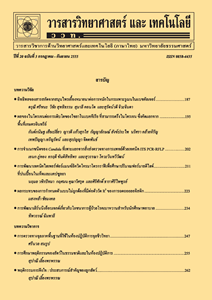Effects of Irrigation Management on Growth and Quality of Greenhouse Melon (Cucumis melo L.)
Main Article Content
Abstract
Optimal irrigation in each growth stage of melon affects a high quality of fruit. The objective aims to study the effects of irrigation at different field capacities on the growth and quality of melon at further development. The experiment was done in a completely randomized design, with 4 treatments, 15 replications, one plant per replication. The melons were grown in a net house in a mixture of coir dust: sand: rice hull (2: 1: 1 v/v). Two experiments were conducted depending on the growth stage. In the first experiment, the irrigation at 40, 60, 80, or 100 % field capacity was applied during the vegetative stage. The results showed 100 % field capacity gave the highest leaf number, stem length, leaf area, fresh weights of shoot and root, and dry weights of shoot and root. The second experiment was done during the fruit setting stage until harvest. The irrigation at 60, 80, 100, or 120 % field capacity was applied. The results found that the irrigation at 120 % field capacity gave the most remarkable leaf area, fresh weights of shoot and root and dry weights of shoot and root, and fruit weight. Total soluble solids in all treatments were in the range of 13.10-14.17 ºBrix. Therefore, irrigation at 100 % field capacity should be applied during the vegetative stage, and 120 % field capacity should be used during the fruit setting stage until harvest.
Article Details
References
Chanthaprom, S., 2015, Planting Melon in a Greenhouse, MIS Published, Bangkok, 129 p. (in Thai).
Tira-umphon, A., 2003, Optimization of Soilless Culture System and Nutrient Solution Formular for Melon Production: Phase II, Research Report, Suranaree University of Technology, Nakhon Ratchasima, 40 p. (in Thai)
Jindagiea, R., Kumlung, A., Verasan, J. and Thongket, T., 2005, Study on the suitable soilless media for cherry tomato (Lycopersicon esculentum cv. CH154), Kasetsart University Annual Conference: Plants 43: 530-540.
Techapinyawat, S., 2005, Plant Physiology, Kasetsart University Press Published, Bangkok, 252 p. (in Thai)
Li, Y.J., Yuan, B.Z., Bie, Z.L. and Kang, Y, 2012, Effect of drip irrigation criteria on yield and quality of muskmelon grown in greenhouse conditions, Agric. Water Manage. 109: 30-35.
Widaryanto, E., Wicaksono, K.P. and Najiyah, H., 2017, Drought effect simulation on the growth and yield quality of melon (Cucumis melo L.), J. Agron. 16: 147-153.
Barzegar, T., Heidaryan, N., Lotfi, H. and Ghahremani, Z., 2018, Yield, fruit quality and physiological responses of melon cv. Khatooni under deficit irrigation, Adv. Hort. Sci. 32: 451-458.
Udomprasert, N., 2015, Plant Stress Physiology, Chulalongkorn University Press Published, Bangkok, 237 p. (in Thai)
Sensoy, S., Ertek, A., Gedik, I. and Kucukyumuk, C, 2007, Irrigation frequency and amount effect yield and quality of field-grown melon (Cucumis melo L.), Agric. Water Manage. 88: 269-274.
Ahmadi-Mirabad, A., Lotfi, M. and Roozban, M.R., 2014, Growth, yield, yield components and water-use efficiency in irrigated cantaloupes under full and deficit irrigation, E. J. Bio. 10: 79-84.
Resh, H.M., 2012, Hydroponic Food Production: A Definitive Guidebook for the Advanced Home Gardener and the Commercial Hydroponic Grower, CRC Press, Boca Raton, FL., 560 p.
Yativ, M., Harary, I. and Wolf, S., 2010, Sucrose accumulation in watermelon fruits: Genetic variation and biochemical analysis, Plant Physiol. 167: 589-596.
Ozbahce, A., Tari, A.F., Yucel, S., Okur, O. and Padem, H., 2014, Influence of limited water stress on yield and fruit quality of melon under soil-borne pathogens, Soil Water J. 3: 70-76.
Higashi, K., Hosoyo, K. and Ezura, H., 1999, Histological analysis of fruit development between two melon (Cucumis melo L. reticulatus) genotypes setting a different size of fruit, J. Exp. Bot. 50: 1593-1597.
Techawongstien, S., 2004, Physiology of Crop Production, Department of Plant Science and Agricultural Resources, Faculty of Agriculture, Khon Kaen University, Khon Kaen, 37 p. (in Thai)
Lawn, R., 1982, Response of four grain legumes to water stress in South-Eastern Queensland, I. Physiological Response Mechanisms, Aust. J. Agric. Res. 33: 481-496.
Kasemsap, P., 2006, Biology 2, The Promotion of Academic Olympiad and Development of Science Education, Bangkok, 440 P. (in Thai)
Wells, J.A. and Nugent, P.E., 1980, Effect of high soil moisture on quality of muskmelon, Hort. Sci. 15: 258-259.
Ministry of Agriculture and Cooperatives, 2016, Thai Agricultural Standard: Melon, Available Source: https://www.acfs.go.th/ standard/download/MELON.pdf, August 14, 2019. (in Thai)


